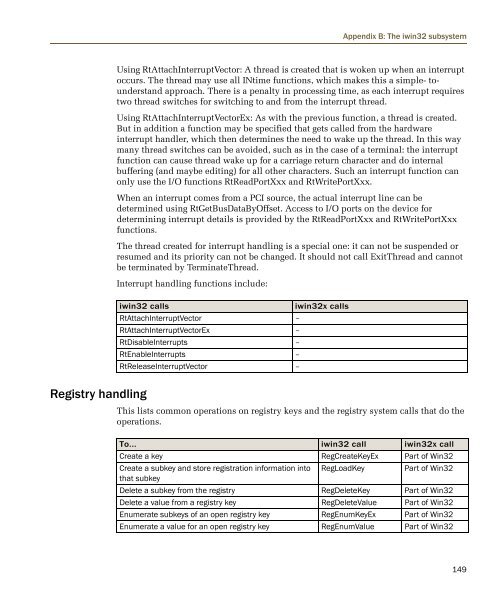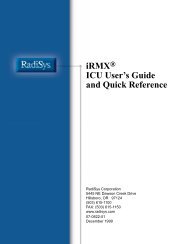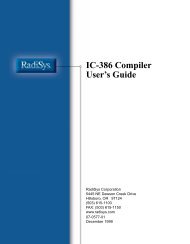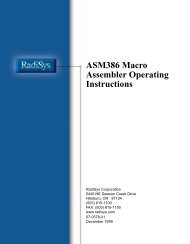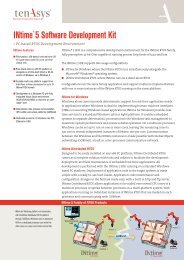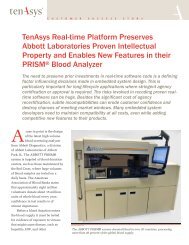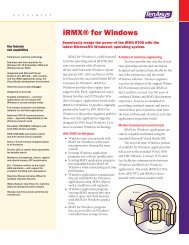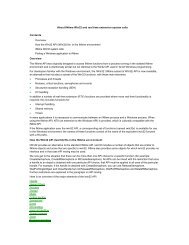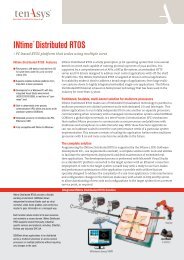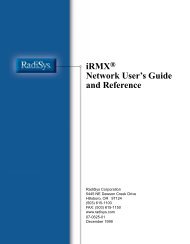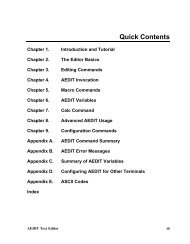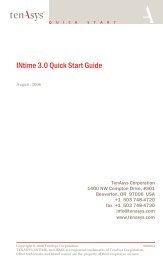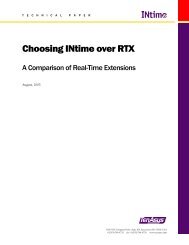INtime® 3.1 Software - tenAsys
INtime® 3.1 Software - tenAsys
INtime® 3.1 Software - tenAsys
You also want an ePaper? Increase the reach of your titles
YUMPU automatically turns print PDFs into web optimized ePapers that Google loves.
Appendix B: The iwin32 subsystem<br />
Using RtAttachInterruptVector: A thread is created that is woken up when an interrupt<br />
occurs. The thread may use all INtime functions, which makes this a simple- tounderstand<br />
approach. There is a penalty in processing time, as each interrupt requires<br />
two thread switches for switching to and from the interrupt thread.<br />
Using RtAttachInterruptVectorEx: As with the previous function, a thread is created.<br />
But in addition a function may be specified that gets called from the hardware<br />
interrupt handler, which then determines the need to wake up the thread. In this way<br />
many thread switches can be avoided, such as in the case of a terminal: the interrupt<br />
function can cause thread wake up for a carriage return character and do internal<br />
buffering (and maybe editing) for all other characters. Such an interrupt function can<br />
only use the I/O functions RtReadPortXxx and RtWritePortXxx.<br />
When an interrupt comes from a PCI source, the actual interrupt line can be<br />
determined using RtGetBusDataByOffset. Access to I/O ports on the device for<br />
determining interrupt details is provided by the RtReadPortXxx and RtWritePortXxx<br />
functions.<br />
The thread created for interrupt handling is a special one: it can not be suspended or<br />
resumed and its priority can not be changed. It should not call ExitThread and cannot<br />
be terminated by TerminateThread.<br />
Interrupt handling functions include:<br />
iwin32 calls<br />
iwin32x calls<br />
RtAttachInterruptVector –<br />
RtAttachInterruptVectorEx –<br />
RtDisableInterrupts –<br />
RtEnableInterrupts –<br />
RtReleaseInterruptVector –<br />
Registry handling<br />
This lists common operations on registry keys and the registry system calls that do the<br />
operations.<br />
To... iwin32 call iwin32x call<br />
Create a key RegCreateKeyEx Part of Win32<br />
Create a subkey and store registration information into RegLoadKey Part of Win32<br />
that subkey<br />
Delete a subkey from the registry RegDeleteKey Part of Win32<br />
Delete a value from a registry key RegDeleteValue Part of Win32<br />
Enumerate subkeys of an open registry key RegEnumKeyEx Part of Win32<br />
Enumerate a value for an open registry key RegEnumValue Part of Win32<br />
149


